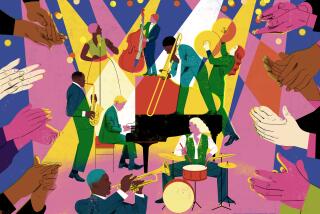Jazz Expert Johnny Guarnieri, Innovator at Piano Bar, Dies
- Share via
Johnny Guarnieri, scion of legendary violin makers who was known in his time as a foremost interpreter of jazz and exponent of stride piano, died Monday morning in Livingston, N.J., where he was visiting.
Guarnieri, for years a mainstay of the Benny Goodman and Artie Shaw bands and a composer of hundreds of songs and instrumental works, was 67. He died of an apparent heart attack.
For more than 10 years Guarnieri, who looked more like an accountant than a purveyor of exotic rhythms, held forth at Tail o’ the Cock restaurant on Ventura Boulevard in North Hollywood.
To his piano bar came such music lovers as Marlon Brando, Jack Lemmon, Mel Brooks and Clint Eastwood, and such fellow pianists as Mel Powell, Eubie Blake, Horace Silver and George Shearing.
What they all came to hear were the compositions of Fats Waller, Duke Ellington, George Gershwin and Jerome Kern, done in Guarnieri’s inimitable 5/4 meter.
Guarnieri fashioned himself as a keeper of America’s songs as they needed to be played, rather than simply danced to.
He was one of the last of a long line of pianists who could not only interpret the legacy of Art Tatum and Waller but intersperse personal asides into his music. They were his friends.
Best remembered commercially as the first jazz musician to play harpsichord (“Summit Ridge Drive” with Shaw’s Gramercy 5), he also was the resident Goodman sextet pianist that gave birth to “Air Mail Special.”
He was a prolific recording artist, with Louis Armstrong, Roy Eldridge, Jimmy Dorsey and Coleman Hawkins and, after leaving the Goodman band, went into radio with Raymond Scott’s experimental group on CBS. That band’s vocalists were two beginning crooners named Frank Sinatra and Perry Como.
The thick, short, bespectacled Guarnieri was born in New York, where he studied classical music. He was a descendant of the Guarnerius family of violin makers but soon abandoned classicism for jazz, beginning in 1937 when he played with George Hall. He was with Goodman in 1939-40, with Shaw in ‘40-41 and then began a lengthy career as an NBC staff musician.
In 1962 Guarnieri came to Hollywood, ostensibly to write and score for films. But, as he noted in a 1967 interview with The Times, “it was a different world; the competition was fierce.”
Here he continued his writing and recording, and was believed to have recorded more than 6,000 titles at his death.
His own compositions ranged from popular songs (“I Would, Would You,” “Blue Mood”) to reconstructions of Paganini and Chopin, whose concerti he freely adapted to his singular style.
Classics and Jazz
With such sidemen as Matty Matlock, Cootie Williams and Nick Fatoll, he gave free jazz concerts at the Pilgrimage Theater, played classics and jazz at the Wilshire Ebell Theater and managed some film scoring.
Then in 1972 he began the first of his nightly appearances in North Hollywood where he discussed and dispersed the 5/4 beat that became his signature.
He remained there until 1982, his left hand striding demoniacally across the lower keys while his right picked out the notes, circling, interpreting and finally embracing the music as written.
If he was a five-beat anachronism in a four-beat world, he never seemed to mind. Even the occasional request for “Tiny Bubbles” didn’t dampen his spirits.
“I’ve learned a lot on this job,” he said as he walked out the door of Tail o’ the Cock . “God has been good to me. In my career I’ve done just about everything I wanted to, except one thing, which I plan to work on now--play even better.”
Guarnieri is survived by his wife, Jeanne Marie; sons John A. Jr. and Anthony; daughters Noelle DeVita, Patricia Larsen-Gaumer, Christine Benham, Gretchen Batis and Jane Guarnieri, and 18 grandchildren. Another son, Peter, died in 1974.
A memorial service is scheduled at noon Saturday at Christ Church on Manhattan Place in Los Angeles.
More to Read
The biggest entertainment stories
Get our big stories about Hollywood, film, television, music, arts, culture and more right in your inbox as soon as they publish.
You may occasionally receive promotional content from the Los Angeles Times.










